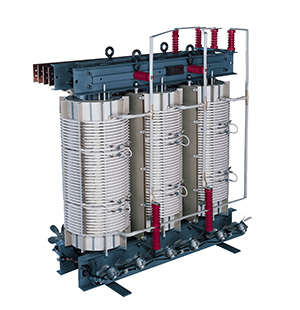Upgrading Campus Power Transformers
 LA VERNE, Calif. — In May 2013, a transformer explosion caused a power outage and forced evacuations at the University of La Verne in La Verne, setting several trees ablaze. Though no one was injured, it was a necessary reminder that schools and universities with aging transformers should quickly take steps to save utility costs and prevent power outages.
LA VERNE, Calif. — In May 2013, a transformer explosion caused a power outage and forced evacuations at the University of La Verne in La Verne, setting several trees ablaze. Though no one was injured, it was a necessary reminder that schools and universities with aging transformers should quickly take steps to save utility costs and prevent power outages.
Although power transformers seldom go down, when they do the effects on campus operations can be immediate and devastating. Beyond the lost continuity of classroom instruction, the risk of subsequent fires, fines, security lapses and lawsuits can quadruple the damages.
At the same time, legacy power transformers represent a huge money drain on an institution’s operating budget when they force the campus to pay a steeper price for stepped-down electricity. With the current move by utility companies to deliver higher and higher voltages from the grid, many schools, colleges and universities must replace their transformers.
“We were looking at a multi-phase process to literally transform our entire campus from a 5KV to 15KV distribution system because our utility company would no longer supply the lower voltage,” said Ben Johnson P.E., assistant director of planning, design, and construction at Western Kentucky University (WKU) in Bowling Green, Ky. “Between that and the occasional failures within our system, not doing anything was no longer an option.”
Aging infrastructure also spurs the need for replacement at many institutions.
“The units in our substation were 40 to 60 years old, and were operating at 120 to 125 percent of capacity,” Johnson said. “Since the utility said they would no longer provide 5KV class service we had to change every primary transformer on campus. Our 4,160-volt system was in rough enough shape and fragile enough that it was not uncommon for us to have three to six major outages per year. That is obviously not acceptable.”
Faced with massive upgrades, whether demanded by an electricity provider or for preventative purposes, many campus facility engineers are now acquiring newer power transformers. Common types of power transformers found on campuses include liquid-filled and dry-type transformers. As dry-types are air-cooled, they pose less chance of leakage and fire risk.
“Whether wet or dry-type, the way the coils are wound around the core of the transformer greatly affects its robustness,” said Alan Ober, vice president of engineering and manufacturing for Electric Service Company (ELSCO). “Because of increased axial forces acting at the corners of rectangular-wound transformers, energy gets wasted and noise is created. On the other hand, voltage stresses are halved between the discs of round-wound designs. Hence, round disc-wound transformers stay cooler, run quieter, present less risk of short circuit and are more energy efficient.”
“Beyond the improved reliability factor, the increased efficiency of the round design saves costs in real time, as the plant consumes less electricity. Some round disc-wound transformers even exceed the proposed efficiency standards for Energy Star compliance, drastically lowering utility costs for a plant,” Ober added.
When it comes to the material used for the windings, copper is a superior conductor to aluminum because it offers less resistance, hence less heat. Additionally, aluminum corrodes which generates heat and reduces lifespan while posing a fire hazard.
Even insulation plays a major part in ensuring reliability as temperatures can reach 200 degrees Celsius in a dry transformer on a daily basis. Glastic fiberglass insulation or Nomex provide significantly greater protection from fires and short circuits than paper insulation.
Too often relegated to last-minute consideration is the need to ensure that any new power transformer fits into existing campus switchgear — carefully duplicating “form, fit and function” as much as possible.
“The main problem I’ve seen with some installations is adapting to existing facilities; it may seem like a small thing but it’s really huge,” Johnson said. “Our old on-campus equipment dated anywhere from the late 1920s to the 1980s. This is where a custom-designed transformer and bus bar, like we get with the ELSCO transformers, really shines. I’m an [electrical engineer] by trade and have been involved in electrical construction for over 25 years, so I have a respect for hardware.”
For those learning institutions that can’t replace their outdated transformers fast enough, accidents will happen, as when a blown transformer caused a power outage at Del Mar College in Corpus Christi, Texas in 2012, immediately halting classes.
To rapidly stem such losses, transformer companies exist that specialize in emergency replacement. For mission critical applications, such as on-campus medical clinics, transformers can be prepped for shipping within a matter of hours. Attention to details such as duplication of the high and low voltage bus bar spells the difference between a lengthy replacement process versus a quick, cost-effective plug-and-play solution that brings the campus back online in minimal time.
“Even though we are a public institution and must put everything out to bid, we are permitted to buy from a sole source to alleviate the emergency,” Johnson said. “Few would argue against a power outage as being an emergency.”
As more campuses like WKU must switch out dozens of distribution transformers, cables and underground vaults, the process will not take place overnight. Johnson recommends tackling the oldest transformers first.
“Of the 58 buildings we have on campus, I’ve still got about 18 to go so we’re still working it,” Johnson said. “We replaced our worst equipment first to get them offline before we had more failures. Since we’ve had two-thirds of our system already replaced, obviously our failure rate has gone way down. We’ve never had any issues out of anything we’ve ever put in.”
